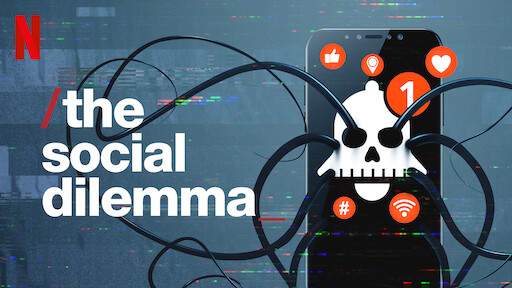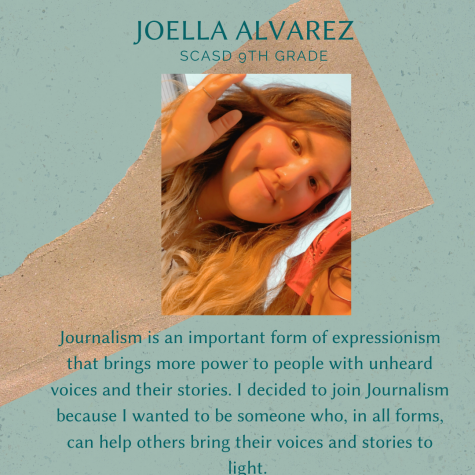The Social Dilemma- Why is it more relevant than ever to watch this documentary?

A promotional photo used for the docufilm, “The Social Dilemma.”
December 13, 2020
The more we learn about the true effects that lie underneath social media and its influence on mental health and society, the more we seem to fall deeper into its trance. This concept is explored in “The Social Dilemma” by Jeff Orlowski, a docufilm that unearths the uncomfortable reality of social media.
The early 2020 Netflix documentary tries to teach its audience that social media is mentally manipulating and rewiring our brains. It explains how the algorithm within social media constantly re-functions to better grab our attention. All of this wasted, attention-grabbing, rabbit hole time we spend on social media leads to mental health deterioration, misinformation, and a more divided world. The contributors of the movie are former executives and creators of some of these media apps who share their concerns on how social media is hurting our society. They claim that this mass manipulation that affects more than 2 billion people is for the profit and gain of the mass media companies like Instagram and Facebook.
“The Social Dilemma” forces us to ask our society the big question: are we forcing ourselves out of the ability to grow, understand, and make decisions together? My answer is yes.
The documentary combines interviews from former executives of media companies with fictional depictions of a suburban family undergoing the direct effects of social media addiction to convey its message. The family showcases an older teen boy succumbing to his media addiction and a younger girl going through mental health issues due to her own media use. The girl is seen deleting posts because she is not getting enough likes, being insecure, and crying about her self image in the mirror. While fictional, this acts as a parallel to many teen girls’ experiences with social media and mental health.
“The Social Dilemma” used this fictional girl to show viewers what social media is really doing to our minds. Caring more about likes, followers, and our body image, as opposed to life outside of social media, eventually leads to more self-hurt.
Some adults who have seen the lives of teenagers before and after the rise of social media in 2009 have noticed the direct effects on mental health. SCASD counselor, Tanya Anderson, discussed her view of life for teens before and after the social media boom.
“I do believe I have seen a connection between social media use and the well-being of students,” Anderson said. “For those students who spend a lot of time on social media, I’ve seen it impact their self-esteem levels as well as contribute to increases in anxiety and depression. These same students also expressed being lonely more often and insecure.”
The documentary gives real statistics on how the media has killed our own self-worth and love. Beginning in 2011-2013, there has been a massive increase in depression and anxiety in American teenagers. The number of teenage girls who have harmed themselves was stable before the boom of social media, but it went up 180% following it.
Direct statistics are telling us we are systemically hurting ourselves with the use of social media, yet we keep using it as our only apparent source of communication and entertainment. Why? What is it about social media that we just want to keep jeopardizing our sanity for? Former executives and creators say it’s the way these apps are run. Executives want you to keep using social media to make more profit and keep you on the app longer. The algorithm for social media is constantly trying to drag you into a rabbit hole of videos and posts that it knows you like.
This direct quote from the movie explains it perfectly: “If you’re not paying for the product, you are the product.”
Every point that this movie tried to make leads back to one main cause: the algorithm. Present in every social media app, this is the main source of manipulation; personalized recommendations, posts, infinite scrolling, ads, and notifications just turn users into the food for advertisers and propagandists. The personalization of everything leads to the majority of individuals developing singular, closed views of the world. The creation of social media birthed the creation of a more divided society. It is taught in society that if we only hear what we want to hear and only listen to people that agree with us, we can never grow to become smarter and better as a society. This is what social media is doing to us.
An example used in the movie is the 2016 U.S. presidential election. If social media users continually liked posts supporting Hillary Clinton, they would get more posts supporting Hillary Clinton over and over, because that’s what the algorithm thinks they liked to see. Because the algorithm knows what side you are on, posts showing up in your future feed are most likely going to be in support of the Democratic party. The algorithm convinces people that their opinion is right, leading to disagreements in the real world.
The algorithm will only show users a world that isn’t reality. Sadly, few are able to recognize this.
“Our current bipartisan divisiveness is, in a lot of ways, a reflection of how social media companies sell us messages: in our echo-chambers of following only people and stories that reinforce our same values or ideas, we rarely view people on the ‘other side’ as human beings. Social media companies battle for our attention; they will try to sell whatever holds our attention the longest. Often, what holds our attention the longest is not feel-good stuff,” State High teacher Meghan McGinty said after watching the docufilm.
When you are only seeing what you want to see, what happens when your view is challenged by someone else’s? You disagree, but you can’t understand their point of view because you have never been forced to. You can’t grow.
Media is not set in stone, it can be changed. We made the choice as a society to prioritize social media, but now, we have to make different choices. Our society can demand more humane products because we aren’t a resource. We are people. How do we do this? We need to share the dilemma, reboot our use, and rebuild the system. Demand change.

